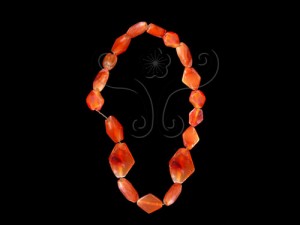|

Introduction
From the Lu-Liao site were excavated 67 nephrite specimens. Among them, more than 92.5% were beads. From inspection with the naked eye they could be divided into carnelian and agate beads.
Agate and carnelian are chalcedony minerals made up of silicon dioxide (SiO2) crystals. Due to the inclusion of ferric oxide, carnelian is translucent red or dark red in color. Agate is formed from the repeated precipitation of silicon dioxide, forming bands of different colors.
Shapes
The surfaces of the chalcedony beads excavated from the Lu-Liao site show evidence of fine grinding and polishing. There are variations in size and shape, including rod-shaped (olive-shaped in appearance, mostly circular on cross-section), flat-shaped (wider surface is rhomboid or circular in shape, rectangular on cross-section), tube-shaped, and sphere-shaped. There are also a few specimens that appear to be fragments of rings.
LL-M0061 is a fragment of a chalcedony object, most likely a ring-shaped object. This fragment contains one protuberance. From an artistic reconstruction, it is possible that this fragment is from a ring-shaped ear ornament that possessed four protuberances and had an inner diameter of 14mm and an outer diameter of 20mm. However, this is just one possibility and no conclusions have been able to be made.
Hole characteristics
There are large variations in the sizes and shapes of chalcedony beads. However, they have one characteristic in common, a single hole. However, one specimen was found with three holes. Usually, a hole was made by boring from both sides and was very small in diameter, as well as consistent in size on the front and back. This implies that the boring techniques at that time were quite advanced. On some of the beads, the contact points between the boring points on the two sides do not match up. Some beads also show a “︿” shape where the holes are not parallel. The two largest and most refined rod-shaped beads have holes that are not in the center but rather to one side. Perhaps these were to be placed in the center of a strand of beads.
Holes were bored from either side along the major axis of rod-shaped beads toward the center. On flat-shaped and sphere-shaped beads, the hole was usually bored on the side.
The international digital archives and e-learning communication project of the National Museum of Natural Science
National Museum of Natural Science
|













